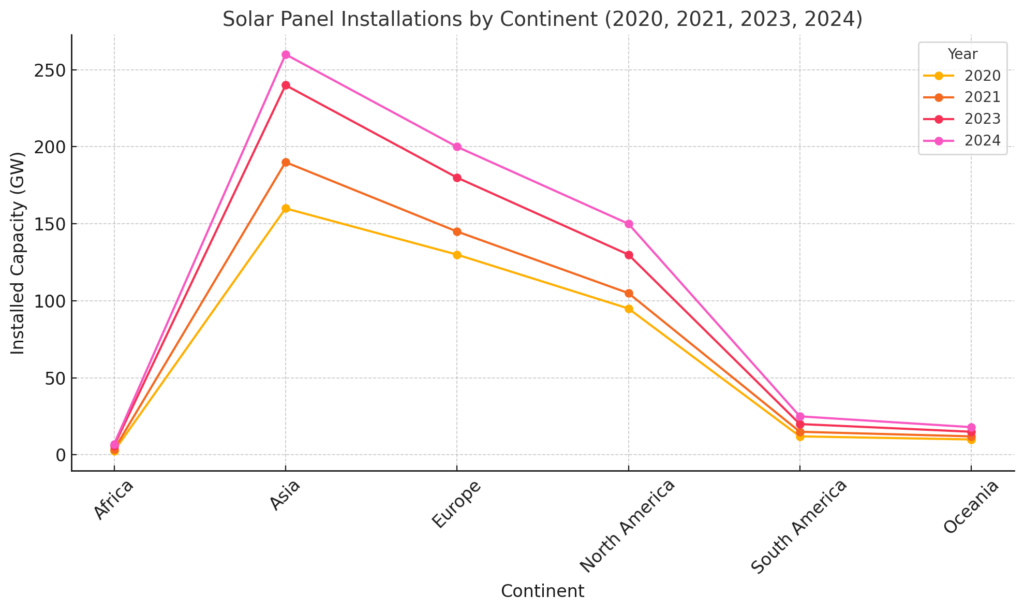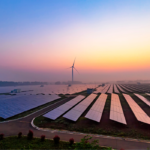Solar panels installation worldwide by continent

Here is the graph showing the solar panel installations by continent for the years 2020, 2021, 2023, and 2024. The data is presented in gigawatts (GW) for each continent over the specified years.
As the world continues to grapple with climate change and the urgent need for sustainable energy solutions, solar power has emerged as a leading candidate for a cleaner, greener future. The solar energy sector has seen exponential growth over the past decade, and this trend is expected to continue well into the future. This article provides a forecast of the global solar energy market, highlighting key trends and predictions for the coming years.
Current Trends
The adoption of solar energy has been accelerating globally, driven by advancements in technology, decreasing costs, and supportive government policies. According to the International Energy Agency (IEA), global solar photovoltaic (PV) capacity reached approximately 710 GW by the end of 2020. This marked a significant increase from previous years, with installations continuing to rise sharply.
Growth Predictions
1. Continued Expansion: The IEA projects that solar PV capacity could reach nearly 2,840 GW by 2030, quadrupling the current capacity. This growth will be propelled by increased installations in key markets such as China, the United States, and the European Union.
2. Cost Reduction: One of the critical factors driving the adoption of solar energy is the continuous reduction in costs. The cost of solar PV modules has decreased by more than 90% over the past decade. This trend is expected to continue, making solar energy more affordable and accessible to a broader range of consumers.
3. Technological Advancements: Innovations in solar technology, such as bifacial panels, perovskite solar cells, and advancements in battery storage, are expected to enhance the efficiency and reliability of solar systems. These technologies will help increase the energy yield and reduce the overall costs of solar installations.
4. Policy Support: Governments worldwide are implementing policies and incentives to promote the adoption of solar energy. For instance, the European Union’s Green Deal aims to make Europe the first climate-neutral continent by 2050, with solar energy playing a crucial role in this transition. Similarly, the United States has rejoined the Paris Agreement and is pushing for significant investments in renewable energy.
5. Market Diversification: While China, the United States, and Europe have been the dominant players in the solar market, emerging economies in Asia, Africa, and Latin America are rapidly increasing their solar capacities. Countries like India, Brazil, and South Africa are investing heavily in solar infrastructure, driven by the need for energy security and sustainable development.
Future Outlook
1. Residential and Commercial Growth: The residential and commercial sectors are expected to see substantial growth in solar installations. As more homeowners and businesses recognize the long-term cost savings and environmental benefits, the demand for rooftop solar systems is set to rise. Innovations such as solar tiles and integrated solar roofing systems will further drive adoption in these sectors.
2. Utility-Scale Projects: Utility-scale solar projects will continue to dominate the market, providing large-scale, reliable, and cost-effective energy solutions. These projects are crucial for meeting national and global renewable energy targets. The development of large solar farms in deserts and other sun-rich regions will play a significant role in this expansion.
3. Integration with Energy Storage: The integration of solar power with advanced energy storage systems will address the intermittent nature of solar energy, ensuring a stable and reliable power supply. Battery storage solutions, such as lithium-ion and emerging technologies like solid-state batteries, will enable solar energy to be stored and used when the sun is not shining.
4. Environmental Impact: The widespread adoption of solar energy will have a profound impact on reducing greenhouse gas emissions and combating climate change. By 2050, solar power could account for over 30% of the world’s electricity generation, significantly decreasing the reliance on fossil fuels and lowering global carbon emissions.




